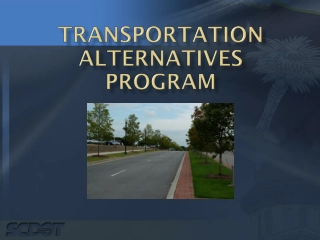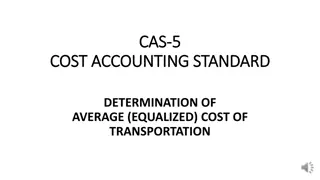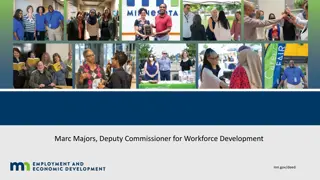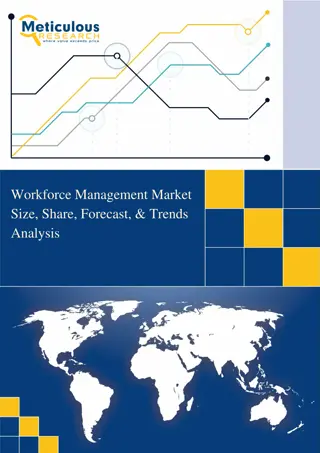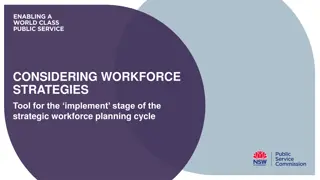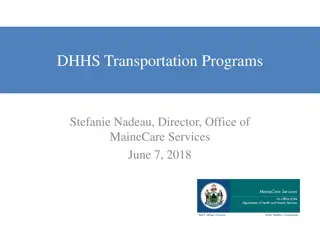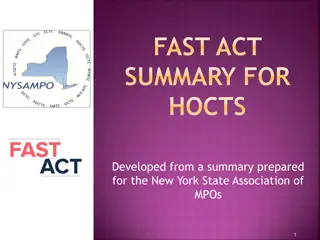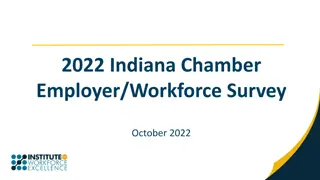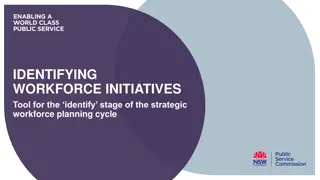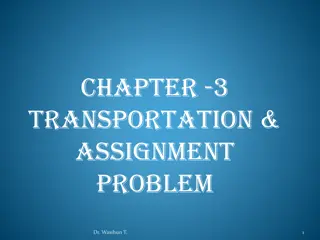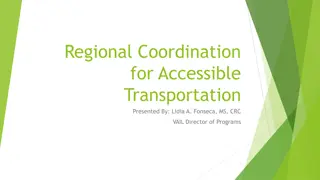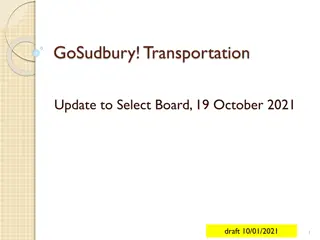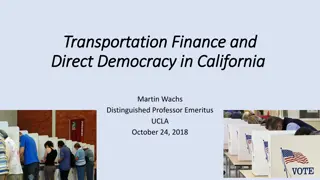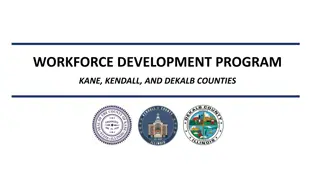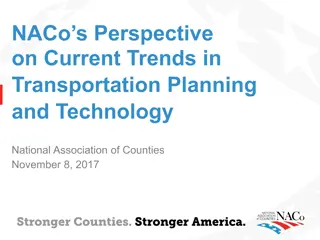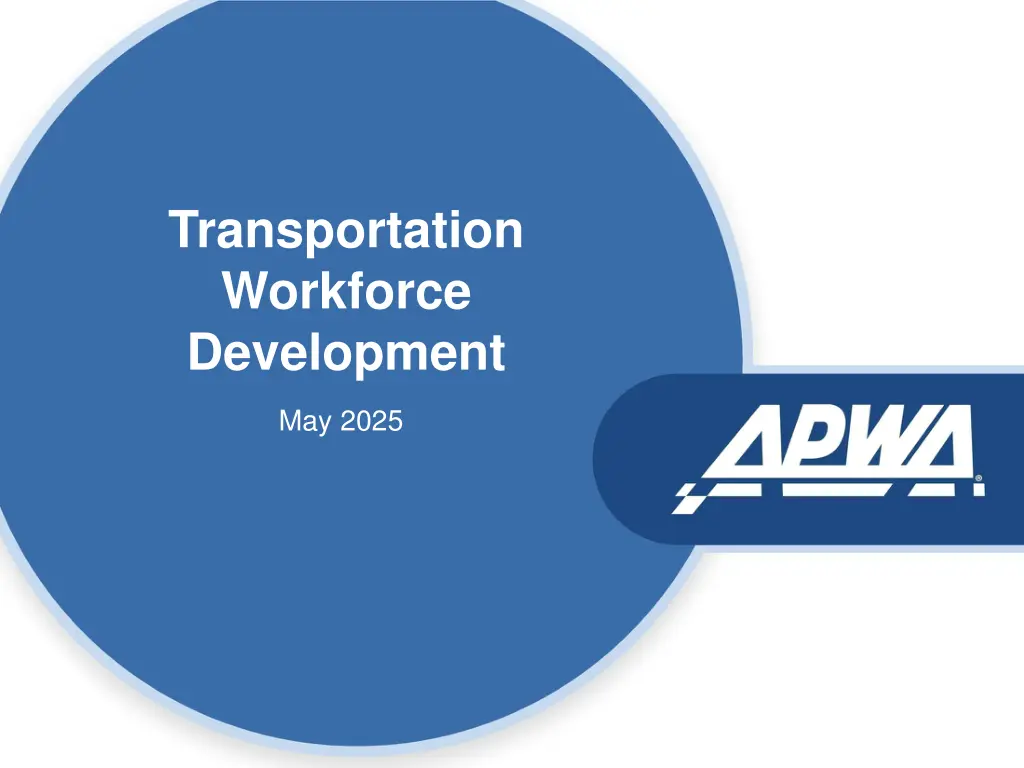
Challenges and Solutions in Transportation Workforce Development
Discover the key challenges faced in the transportation industry, such as retirements and separations, recruitment issues, and the development of career pathways. Learn about unique subsectors affected by workforce shortages and explore solutions for training, retention, and onboarding. Addressing these challenges is crucial for ensuring a skilled and sustainable transportation workforce.
Download Presentation

Please find below an Image/Link to download the presentation.
The content on the website is provided AS IS for your information and personal use only. It may not be sold, licensed, or shared on other websites without obtaining consent from the author. If you encounter any issues during the download, it is possible that the publisher has removed the file from their server.
You are allowed to download the files provided on this website for personal or commercial use, subject to the condition that they are used lawfully. All files are the property of their respective owners.
The content on the website is provided AS IS for your information and personal use only. It may not be sold, licensed, or shared on other websites without obtaining consent from the author.
E N D
Presentation Transcript
Transportation Workforce Development May 2025
Key Public Works Transportation Subsectors Construction Bus service and urban transit Services related to transportation Air transportation Water transportation Warehousing and storage Architectural, engineering, and related services Rail transportation S O U R C E U.S. Bureau of Labor Statistics.
Key Transportation Workforce Challenges: Retirements and Separations Key Separation Statistics 96% of public transit agencies have reported a workforce shortage, 84% of which have experienced disrupted service 43% of transit workers are over 55, nearly double the percentage of the broader transportation sector Only 36% of current transit workers feel their pay is competitive with similar jobs; compensation and scheduling are the leading reasons why workers quit Unique subsectors: Due to their smaller size, the railroad and maritime subsectors could be particularly affected by significant portions of retiring workers Contributing factors to vacancy in the transportation workforce: Occupational transfers (28%) Retirements (17%) Other exits S O U R C E American Public Transportation Association.
Key Transportation Workforce Challenges: Recruitment, Training and Onboarding 36% of transit hires leave the agency during the training and probationary period Jobs in operations and maintenance are in particularly high demand The COVID-19 pandemic forced agencies to shift training and onboarding programs as well as shifted worker priorities, with more importance placed on work-life balance Nearly 50% of transit agencies noted that drug and alcohol testing was a barrier to hiring and retention S O U R C E American Public Transportation Association.
Key Transportation Workforce Challenges: Career Pathways A key aspect of developing career pathways for the transportation workforce is job training, including technical education programs, apprenticeships, pre-apprenticeship programs, and workplace trainings Six key elements 4 1 Cross-agency partnerships and role clarity Identifying funding needs 2 5 Employer engagement Policy and program alignment 6 3 Measurement of change and performance Education and training S O U R C E U.S. Department of Education, U.S. Department of Transportation, U.S. Department of Labor.
Key Transportation Workforce Challenges: Agency Solutions to the Workforce Shortage Expanding recruitment capacity is essential for ensuring adequate staff and resources. This includes advertising positions in new media and having a physical presence in the community. 1 Recruiting Some agencies have developed ways to process high volumes of applicants, while others are working on strategies to expand the applicant pool. 2 Hiring Training and the work transition is a critical part of onboarding, helping to prepare employees and contribute to a positive agency culture. 3 Training and Onboarding Working Conditions and Policies Work-life balance, predictability, and compensation are highly valuable to transportation workers, and agencies should make changes to increase the appeal of the industry. 4 Building Culture and Improving Morale Agencies can attract new workers and retain existing ones through engagement, celebrating accomplishments, and providing pathways for career growth. 5 S O U R C E American Public Transportation Association.
Growth in Transportation and Warehousing Industry Jobs, 2020-2025 <0% 0-5% 5-10% 10-15% 15-20% >20% AK ME 8.7% 16.9% VT 0.0% NH 9.6% WA 4.2% ID MT 28.5% ND 5.5% MN 11.3% IL WI 4.2% MI NY RI MA 8.7% 18.5% 3.5% 19.8% 11.7% 20.0% OR NV WY 4.0% SD 0.0% IA IN OH 10.6% PA NJ CT 19.0% 14.9% 12.7% 15.0% 14.5% 24.3% 23.6% CA UT 9.7% CO NE 3.1% MO 0.2% KY 0.0% WV -0.2% VA 3.7% MD 14.6% DE 19.4% 23.1% 14.7% AZ NM -4.0% KS 8.4% AR TN NC 5.0% SC 22.4% 14.5% 23.5% 13.9% OK 3.2% LA 6.7% MS -3.8% AL 9.4% GA 27.7% HI TX FL 8.3% 21.0% -4.3% S O U R C E Arizona State University.
Transportation workforce employment over time Number of individuals employed (total for key public works transportation subsectors) 17.3 M 17.2 M 16.3 M 16.2 M 15.5 M 2019 2020 2021 2022 2023 -5.01% +4.89% +6.46% -0.43% S O U R C E U.S. Bureau of Labor Statistics.
Transportation and Utilities Workforce Employed a Total of 8.45 Million People in 2023 Number of individuals employed in 2023 by selected industries Air transportation 734,000 Rail transportation 236,000 Water transportation 78,000 Truck transportation 2,221,000 Bus service and urban transit 457,000 Taxi and limousine service 602,000 Pipeline transportation 41,000 S O U R C E U.S. Bureau of Labor Statistics.
Percent of Women Among Employed Individuals in Selected Industries in 2023 Bus service and urban transit 38.0% Warehousing and storage 34.0% 46.9% Air transportation 33.0% Female employment rate across all labor industries Water transportation 32.0% Architectural, engineering, and related services 26.0% Services related to transportation 23.0% Rail transportation 8.0% S O U R C E U.S. Bureau of Labor Statistics.
Racial Demographics in the Public Works Transportation Workforce, 2023 Black/African American Asian Hispanic/Latino 12.8% 10.3% Architectural, engineering, and related services 7.6% 6.5% Black/African American employment rate across all labor industries 11.8% Rail 1.6% transportation 15.4% 15.9% Water transportation 3.3% 17.6% 6.9% 17.0% Air 7.0% transportation Asian employment rate across all labor industries 16.0% 21.0% Services related to transportation 7.4% 18.3% 18.8% 37.2% Warehousing and storage 4.0% 23.0% Hispanic/Latino employment rate across all labor industries 19.2% 3.6% Bus service and urban transit 34.2% S O U R C E U.S. Bureau of Labor Statistics.
Demographic Changes Over Time in the Public Works Transportation Workforce Women Black or African-American 26.3% 25.8% 25.8% 25% 23.8% 18.9% 17.2% 16.3% 16.2% 15.3% 2019 2020 2021 2022 2023 2019 2020 2021 2022 2023 Asian Hispanic or Latino 20.8% 19.3% 19.1% 18% 17.8% 5.4% 5.3% 5% 5% 4.5% 2019 2020 2021 2022 2023 2019 2020 2021 2022 2023 S O U R C E U.S. Bureau of Labor Statistics.
Age Breakdown for Key Public Works Transportation Subsectors, 2023 16 to 19 years 20 to 24 years 25 to 34 years 35 to 44 years 45 to 54 years 55 to 64 years 65 years and over 100% 75% 50% 25% 0% Air transportation Architectural, engineering, and related services Bus service and urban transit Rail transportation Services related to Warehousing and storage Water All labor industries transportation transportation S O U R C E U.S. Bureau of Labor Statistics.
Median Age Among Employed Individuals by Industry, 2023 All industries 42.1 Air transportation 43.9 Architectural, engineering, and related services 42.6 Bus service and urban transit 50.2 Rail transportation 42.8 Services related to transportation 43.6 Warehousing and storage 36.9 Water transportation 46.9 S O U R C E U.S. Bureau of Labor Statistics.
Definitions Services related to transportation: Jobs that support the transportation industry but aren't necessarily specific to it. i.e. tow truck operators, mechanics, dispatchers, etc. Warehousing and storage: Industries primarily engaged in operating warehousing and storage facilities for general merchandise; they may also provide a range of services, often referred to as logistics services, related to the distribution of goods including labeling, breaking bulk, inventory control and management, light assembly, order entry and fulfillment, packaging, pick and pack, price marking and ticketing, and transportation arrangement All industries: The all industries category takes the median value of employees across the various industries; an umbrella category containing the data of all workforces in the US Bureau of Labor Statistics dataset; the national average Median: calculated by taking the middle value, the value for which half of the observations are larger and half are smaller; the advantage of the median is that it removes extreme measurements from a data set (i.e CEO salary)

